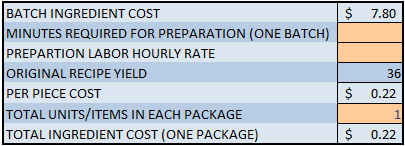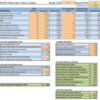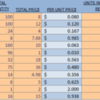What makes the difference between a cookie aficionado and a cookiepreneur? Profit! Remember we are talking business here, and the bottom line is the bottom line.
I am going to dive right into this two-part series. Part I, Creating a Successful Costing Model, is going to teach you how to figure out the actual direct cost of your products. We will discuss all the direct cost components, including raw ingredients, labor, and packaging. In Part II, Pricing Your Cookies for Profit, we will delve into indirect costs* and profit margin. At the end of these two posts, you should know exactly how much your cookies are costing you and what your markup should be so that you are operating in the black. (*Note: Indirect or allocated costs are those costs that relate to the general running of your business, not directly to the making of the cookies, such as rent, insurance, and utilities. They too must be taken into account in order to accurately price your cookies for profit.)
After frequenting several cookie forums over the past couple of years, I have seen numerous questions regarding cookie pricing. A few members of our cookie community have offered assistance by providing samples of their own cookie pricing charts for reference. Although these guides are all well intended, trying to use someone else’s cookie pricing chart is like using some else’s prescription lenses.
Each one of you creates a unique product. There are a number of factors that contribute to your overall cost per cookie. Even if we were to assume that you are using the exact ingredients as a fellow decorator, your rate of speed, cost of ingredients, indirect costs, and overall processes differ; therefore, the only way to guarantee profitability is to figure out your own costs accurately and price your cookies accordingly.
1.0 What is a Costing Model and Why Do I Need One?
Simply stated, a costing model is a tool that helps business owners figure out the cost of certain activities or processes - in this case, those costs related to baking, decorating, and packaging cookies. (Again, in this post, we will only discuss the direct costs associated with producing your cookies. Our next post will undertake profit margins and indirect or allocated costs.) An accurate costing model is an essential tool, as it will help you determine a more exact direct cost per cookie than back-of-the-envelope estimates ever can.
However, your model is only as good as the information you input. Be sure to be meticulous and methodical in your measurements of both materials and time. At first all the number-crunching may seem tedious, but in the end it will pay off.
Not too long ago, I admit I was costing as if I were living in the dark ages. I used an old spreadsheet to calculate the cost of my ingredients and was manually figuring in my labor and packaging costs in addition to my overhead, which added up to one big mess in a notebook.
Upon discovery of the magnificent tool you see pictured below, I have abandoned my antiquated way of doing things and embraced this new approach.
Source: The Food Product Cost and Pricing Calculator, Jennifer Lewis
This tool, The Food Product Cost and Pricing Calculator, was created by Jennifer Lewis who is also the brainchild behind smallfoodbiz.com. Jennifer is a seasoned culinary professional who founded her own small food company in 2006 and holds an MBA with a concentration in entrepreneurship, marketing, and finance from Northwestern University's Kellogg School of Management. Her website is chock full of detailed information helpful to all who wish to start a small food business.
You can purchase this useful tool for a mere $49 here on Jennifer's site. This post is not a paid endorsement of this product; I have simply fallen in love with it and now find it a "must have." This Excel-based spreadsheet saves me countless hours of work and guarantees the accuracy of my margins, so long as the information I input is correct.
In the remaining sections, I'll show you how this model works by taking you through its various costing spreadsheets, each of which corresponds to a particular direct cost component, such as raw ingredients, labor, and packaging. You could, of course, opt to create a spreadsheet of your own or to do the calculations on paper, but in any scenario, the essential costing steps are the same.
2.0 Calculating Raw Ingredients Costs
Begin by making a list of all the raw materials needed to create your recipe.
Before you start to figure your cost per unit, you will need to break down the cost of each raw material called for in your recipe, as shown in the spreadsheet below.
For purposes of example, I've computed the ingredient costs for 36 of my Wacky Cookies' (3-inch-diameter, 1/4-inch-thick) sugar cookie rounds, very simply iced in a single color with a single detail such as a heart. All orange cells are input cells (ones you, the user, must calculate and enter); all blue cells are automatically computed by the model.
2.1 Ingredient Costs, In More Detail
Let’s begin with the flour. I buy all-purpose flour in 25-pound bags, which is equivalent to about 100 cups of sifted flour (assuming 4 ounces of sifted flour per cup*). A 25-pound bag of flour costs me $8, so I divided the total price of the flour by 100 cups, which leaves me with a cost per unit of $.08 (8 cents) per cup.
*Note: Flour (and other dry ingredient) weight-to-volume equivalencies can vary widely with type of flour (i.e., all-purpose versus cake), whether you sift, and how you measure the flour into the cup, so best practice is to weigh your ingredients if you have a scale. That said, here is an excellent weight-to-volume equivalency chart that you can use to convert units if you'd rather measure by volume.
In order to accurately figure out your total ingredient cost per unit, you must repeat this process with each and every ingredient called for in your recipe, as I have done in the spreadsheet above.
2.2 Per Unit Ingredient Costs, In More Detail
Again, using the flour as an example, my recipe calls for 6 cups of flour. Each cup of flour is $.08 and so the model multiplies 6 by $.08 to arrive at the total cost for flour per recipe of $.48.
Once you have completed the above process for each of your ingredients, the spreadsheet adds them together to get the total cost of your raw materials, which in this case is $7.80. The spreadsheet then divides the total ingredient cost by the entered recipe yield (in this case, 36 cookies) to give me an ingredient cost per unit (cookie) of $.22.
3.0 Calculating Direct Labor Costs
When it comes to decorated sugar cookies, labor costs usually far exceed raw ingredients costs. The countless hours of work and attention to detail are what make these edible pieces of art so special. You could use your better judgment to estimate how long it takes you to complete a batch of cookies from start to finish. But better yet, I recommend establishing standards for cookie types by setting a timer while you work. For example, here's the breakdown of how long it takes me to make 36 simply decorated 3-inch cookies:
- Dough prep time (10 minutes)
- Cut and bake time (25 minutes)
- Royal icing prep time (10 minutes)
- Icing/decorating time (20 minutes)
Total estimated time for production is 65 minutes. In order to figure out my direct labor costs per batch, I divide my hourly rate of $12.00 by 60 minutes to get a labor rate of $.20 per minute. I then multiply $.20 per minute by 65 minutes to arrive at a total direct labor cost per batch of $13.00. To compute cost on a per cookie basis, I simply divide $13.00 by the recipe yield (36 cookies) which gives me $.36 per unit (cookie) for labor. (Of course, if you have Jennifer's spreadsheet, all you have to do is enter the total recipe prep time, your hourly rate, and the yield, and the spreadsheet does the math for you!)
My direct costs, excluding packaging, are now:
raw ingredients ($.22) + direct labor ($.36) = $.58 per unit (cookie)
4.0 Calculating Packaging Costs
And let's not forget packaging - it can rapidly add up! You must account for everything from the cellophane bags in which you place your cookies to the ribbons and/or stickers used to seal those bags shut. (And boxes and peanuts for packaging if the cookies are being shipped, though I typically handle shipping costs as indirect costs. More on this topic in Part II.)
The first spreadsheet below shows my typical packaging materials costs per cookie without taking packaging labor into consideration. To arrive at these figures, I basically repeated the same process that I used to calculate my raw ingredient costs - that is, I divided the total price of each packaging element (i.e., a box of cellophane bags) by the units it contained (i.e, number of bags in the box). Since I use 1 bag, 1 sticker, and 1 foot (1/3 yard) of ribbon to package each cookie, I end up with total packaging materials costs per cookie of $.27 when all three packaging elements are added together.
Always remember to roll tax and the costs of shipping (to you) into the price of your bags, ribbons, and labels. Normally, I order many of my paper/packaging products together, so I divide the total shipping cost of my order by the number of items that have been shipped to me. I then roll that figure into the total price of the packaging item. For instance, I entered $65.00 for 2,000 cello bags when the price was actually $60.00, because I needed to add another $5.00 to cover the shipping costs and tax.
Let's briefly revisit our direct cost tally. We are now up to $.85 per unit (cookie), excluding packaging labor:
raw ingredients ($.22) + direct labor ($.36) + packaging materials ($.27) = $.85 per unit (cookie)
4.1 Packaging Labor, In More Detail
When I first started getting very busy with cookie orders, packaging time was one factor for which I hadn't sufficiently prepared. After all, you cannot just shove your beautiful cookies, which may have taken you hours to create, into an unattractive bag or box and hope that your customers will be impressed.
Packaging cookies takes a good amount of time and care. You must accurately calculate how long it typically takes to bag cookies, cut the ribbon and tie the bags, or otherwise package a batch of your product. (Again, I handle labor associated with packaging for shipping as an indirect cost, for reasons I'll discuss in Part II.)
I invite you to compare the price of packaging before and after labor costs are taken into consideration; it is quite an eye opener! And this is just the time for bagging, tying up, and placing a sticker on each bag.
As with production labor, this calculation will require some standard setting - so take out that timer if you don't already have a clear idea of how long these tasks take you. Note: I have used an hourly packaging labor rate that is significantly lower than the baking and decorating hourly rate. This is due to the nature of the job, so when choosing an hourly labor rate, ask yourself how much you are willing to pay someone (or yourself) to do this job.
5.0 Total Direct Cost Per Unit
We have now arrived at our total direct cost per unit which is $1.08, for a very simply decorated cookie. More complicated cookies could very well drive labor costs much higher (think multiples of the ingredient cost), so you can see why it's crucial to cost cookies to your particular design and circumstance. Again, this figure does not yet include overhead costs which we will discuss in Part II, Pricing Your Cookies For Profit.
I hope you find this information both helpful and revealing. As always, I welcome your comments and questions.
And remember that the key to success is persistence. Never give up, never!

Aymee VanDyke, also known as Cookiepreneur, is a successful entrepreneur and business consultant whose main focus is to help women in the cottage food industry build profitable and rewarding businesses. She is the founder and owner of Cookiepreneur and The Wacky Cookie Company, a four-year-old cottage/commercial cookie business that has operated in the black for most of its existence. Aymee has an extensive background in personal development and attended the Norwegian School of Business in Oslo. Her articles have been published in BISSI, the magazine of the Norwegian School of Business, and Somos Magazine.
Photo credit: Aymee VanDyke
Note: From Dough to Dollars is a regular Cookie Connection blog feature written by Aymee VanDyke that provides business planning, marketing, and other tips for starting a cottage cookie business and taking it to the next level. Its content expresses the views of the author and interviewees, and not necessarily those of this site, its owners, its administrators, or its employees. To catch up on all of Aymee's past posts, click here.


















Comments (35)